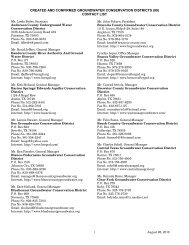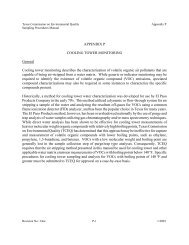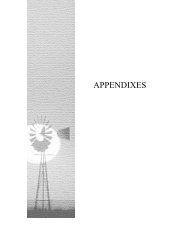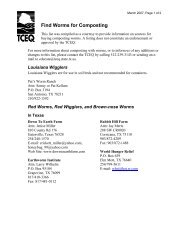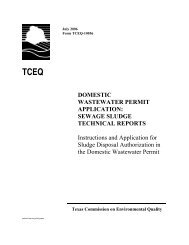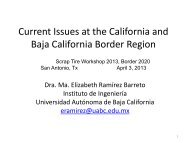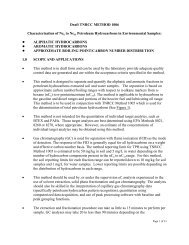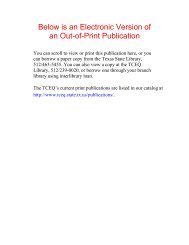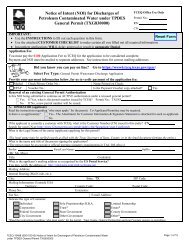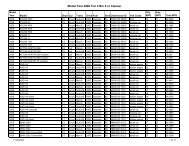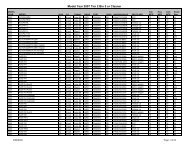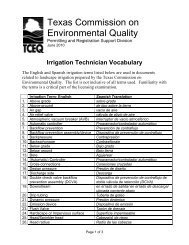Texas Commission on Environmental Quality - TCEQ e-Services ...
Texas Commission on Environmental Quality - TCEQ e-Services ...
Texas Commission on Environmental Quality - TCEQ e-Services ...
You also want an ePaper? Increase the reach of your titles
YUMPU automatically turns print PDFs into web optimized ePapers that Google loves.
Instructi<strong>on</strong>s for completing Form <strong>TCEQ</strong>-0152Request for Authorizati<strong>on</strong> for Disposal of a Special WasteGenerators must complete and submit form <strong>TCEQ</strong>-0152 to request authorizati<strong>on</strong> to dispose of a special wastein a municipal solid waste (MSW) landfill. All required fields must be completed for authorizati<strong>on</strong>.A. General Informati<strong>on</strong>Generator Name – The name of the generator or facility that generated the waste for which the request issubmitted. (In some cases a "Broker" will be identified as the generator. A "Broker" is a company in <str<strong>on</strong>g>Texas</str<strong>on</strong>g>that assists a company in Mexico.)Generator Mailing Address – The mailing address of the site at which the waste was generated.Generating Site Locati<strong>on</strong> – The physical address or locati<strong>on</strong> of the site at which the waste wasgenerated.<str<strong>on</strong>g>Texas</str<strong>on</strong>g> Registrati<strong>on</strong> Number – For informati<strong>on</strong> regarding <str<strong>on</strong>g>Texas</str<strong>on</strong>g> Registrati<strong>on</strong> Numbers, c<strong>on</strong>tact theRegistrati<strong>on</strong> and Reporting Secti<strong>on</strong> at (512) 239-6413.<str<strong>on</strong>g>Texas</str<strong>on</strong>g> Waste Code – For informati<strong>on</strong> regarding <str<strong>on</strong>g>Texas</str<strong>on</strong>g> Waste Code, c<strong>on</strong>tact the Registrati<strong>on</strong> andReporting Secti<strong>on</strong> at (512) 239-6413.Generator C<strong>on</strong>tact – Name of the pers<strong>on</strong> employed by the generating facility. Teleph<strong>on</strong>e, fax and emailshould be included.Representative Mailing Address – Address of the pers<strong>on</strong> submitting the request (if different fromgenerator, e.g., Broker, C<strong>on</strong>sultant). Teleph<strong>on</strong>e, fax and email should be included.Requested Destinati<strong>on</strong> of Waste – The requestor must specify the municipal solid waste (MSW)landfill name, permit number, mailing address, physical address, teleph<strong>on</strong>e number (with area code) andpoint of c<strong>on</strong>tact name.B. Waste / Chemical Compositi<strong>on</strong>Descripti<strong>on</strong> of Waste – Brief descripti<strong>on</strong> of the waste for which the request is submitted. Descripti<strong>on</strong>should include the material, c<strong>on</strong>taminants, and source of c<strong>on</strong>taminati<strong>on</strong>. Attach available chemicalanalysis results including sample documentati<strong>on</strong>, quality c<strong>on</strong>trol data for each analysis, and chain ofcustody, material safety data sheets, and/or any process knowledge used to characterize the waste. (seedetailed instructi<strong>on</strong> – last 2 pages of instructi<strong>on</strong>s)Descripti<strong>on</strong> of Process Generating the Waste – A brief descripti<strong>on</strong> of the process that caused thematerial to become a waste.Volume of Waste – Indicate the volume of waste to be disposed in cubic yards, and disposal frequency(<strong>on</strong>e-time, weekly, m<strong>on</strong>thly, or annual shipment).Percentage of Materials Comprising the Waste – List the materials that make up the waste, andtheir proporti<strong>on</strong>s.Physical Characteristic of Waste – Indicate whether solid, semi-solid, powder or liquid.Free Liquid? – Indicate whether the waste c<strong>on</strong>tains free liquids (free liquids are prohibited from landfilldisposal).Flash Point – Flash point measured for the material to be disposed.pH – pH of the material to be disposed (used primarily for wastes that exhibit very basic or acidiccharacteristics).C. Generator / Representative Certificati<strong>on</strong>Requestor MUST sign and date the form before submittal to the <strong>TCEQ</strong>.D. Submissi<strong>on</strong>s opti<strong>on</strong>sThis form can be submitted to <strong>TCEQ</strong> by mail, fax or email. Please allow 14 days for the authorizati<strong>on</strong>process. Each submittal will receive an agency resp<strong>on</strong>se.<strong>TCEQ</strong>-0152 (rev. 09/22/11) Page 3 of 5
Part I.Introducti<strong>on</strong>Waste Classificati<strong>on</strong>Documentati<strong>on</strong> RequirementsThe <str<strong>on</strong>g>Texas</str<strong>on</strong>g> <str<strong>on</strong>g>Commissi<strong>on</strong></str<strong>on</strong>g> <strong>on</strong> Envir<strong>on</strong>mental <strong>Quality</strong> (<strong>TCEQ</strong>) randomly audits a porti<strong>on</strong> of waste streamnotificati<strong>on</strong>s in order to ensure proper classificati<strong>on</strong> and coding of waste in <str<strong>on</strong>g>Texas</str<strong>on</strong>g>. When a generatorreceives a request for informati<strong>on</strong> for the purpose of an audit, the informati<strong>on</strong> that a generator hasgathered to classify and code his waste stream must be submitted to the <strong>TCEQ</strong>. The following informati<strong>on</strong>may assist you in gathering the analytical data, quality c<strong>on</strong>trol data, sample documentati<strong>on</strong> and/or processknowledge that may be used in classifying and coding a waste stream.Part II.Hazardous Waste Determinati<strong>on</strong>The first step in the waste classificati<strong>on</strong> process is the hazardous waste determinati<strong>on</strong>. To dem<strong>on</strong>strate thata waste is not a hazardous waste it is necessary to dem<strong>on</strong>strate that the waste: 1) is not a listedhazardous waste as defined in 40 Code of Federal Regulati<strong>on</strong>s (CFR) Part 261, Subpart D and 2) is not acharacteristically hazardous waste as defined in 40 Code of Federal Regulati<strong>on</strong>s Part 261, Subpart C.Documentati<strong>on</strong> used to support the hazardous waste determinati<strong>on</strong> is described below:Process KnowledgeIf process knowledge is utilized in the classificati<strong>on</strong> of a waste, that process knowledge must be documentedand maintained. (Please note that process knowledge must be maintained in some type of written orelectr<strong>on</strong>ic storage format. It cannot be stored solely in some<strong>on</strong>e's mind.) The process knowledge mustsupport a generator's rati<strong>on</strong>ale as to why the waste has been designated a particular classificati<strong>on</strong>. It mustalso support the generator's rati<strong>on</strong>ale as to why a particular test method was not performed, limiting theamount of analytical testing required.The following are examples of process knowledge which may assist in waste classificati<strong>on</strong> determinati<strong>on</strong>s.• Material Safety Data Sheets (MSDSs) (Please note that not all MSDSs c<strong>on</strong>tain informati<strong>on</strong> <strong>on</strong> allc<strong>on</strong>stituents found in a product. MSDSs were not created for the purpose of <str<strong>on</strong>g>Texas</str<strong>on</strong>g> wasteclassificati<strong>on</strong> determinati<strong>on</strong>s. They may be a helpful tool in determining what could be in the waste,but cannot be used for determining what is not in the waste.)• manufacturer's literature• identificati<strong>on</strong> of chemicals/materials involved in the waste stream generati<strong>on</strong> process (includingany potential break down products)• full descripti<strong>on</strong> of waste stream generati<strong>on</strong> activities• identificati<strong>on</strong> of potential c<strong>on</strong>taminants• other documentati<strong>on</strong> generated in c<strong>on</strong>juncti<strong>on</strong> with a particular process• preliminary testing resultsAnalytical DataWhen process knowledge does not sufficiently support a particular classificati<strong>on</strong>, analytical data describedin this part must be documented. If a generator utilizes analytical data to classify a waste, it must besupported by <strong>Quality</strong> C<strong>on</strong>trol Data and Sample Documentati<strong>on</strong> informati<strong>on</strong>. This part outlines informati<strong>on</strong>that must be maintained when analytical data is utilized for classificati<strong>on</strong> purposes.• Sampling Procedures−−dates of sample collecti<strong>on</strong>descripti<strong>on</strong> of the site and/or unit from which the sample was taken, including samplinglocati<strong>on</strong>s<strong>TCEQ</strong>-0152 (rev. 09/22/11) Page 4 of 5
−−−the method of sampling and equipment used for samplinga descripti<strong>on</strong> of the sampling techniques, including collecti<strong>on</strong>, c<strong>on</strong>tainerizati<strong>on</strong>, andpreservati<strong>on</strong>rati<strong>on</strong>ale for the sampling plan (why does the number, type and locati<strong>on</strong> of samples takenaccurately represent the waste stream being characterized)• Chain of Custody• Analytical Data−−−−analytical results with quality c<strong>on</strong>trol data, this includes at a minimum when applicable;spike recoveries (matrix, blank, method, etc.), duplicates, blanks, c<strong>on</strong>tinuing calibrati<strong>on</strong>samples, interference check samples, and laboratory specific recovery and % RPD for thec<strong>on</strong>stituents and methods.identificati<strong>on</strong> of analytical methods (including any preparatory methods)identificati<strong>on</strong> of detecti<strong>on</strong> limitsidentificati<strong>on</strong> of the laboratory performing the analytical analysisPart III.−documentati<strong>on</strong> which satisfactorily dem<strong>on</strong>strates that lower levels of quantitati<strong>on</strong> are notpossible (This is <strong>on</strong>ly necessary when a n<strong>on</strong>hazardous waste is being evaluated against theClass 1 criteria and matrix interferences of the waste causes the Practical Quantitati<strong>on</strong> Limit(PQL) of a Class 1 toxic c<strong>on</strong>stituent (Appendix 1, Table 1-Appendix B of this guideline) to begreater than the Maximum C<strong>on</strong>centrati<strong>on</strong> listed.)Classificati<strong>on</strong> ChecklistThe classificati<strong>on</strong> checklist (which can be found in <strong>TCEQ</strong> Publicati<strong>on</strong> Number RG-22 * ) can be used as aguideline in the classificati<strong>on</strong> of industrial waste and hazardous waste. A completed checklist submitted foran audit does not represent sufficient documentati<strong>on</strong>. When utilizing the Checklist in waste classificati<strong>on</strong>, agenerator should support a resp<strong>on</strong>se ("yes" or "no") by analytical data and/or process knowledge. (Agenerator must be able to dem<strong>on</strong>strate why an answer "yes" or "no" appears <strong>on</strong> the checklist for a particularquesti<strong>on</strong>.)For example, a generator answers "no" to the questi<strong>on</strong> "Is the waste ignitable per 40 CFR §261.21." Thegenerator can support this resp<strong>on</strong>se by submitting either analytical data and/or process knowledge. Ifprocess knowledge is used, it must be specific. A general statement such as "The waste is not ignitable."would not be sufficient. If, however, the generator (1) reviews all c<strong>on</strong>stituents that may be present in thewaste; (2) determines that each c<strong>on</strong>stituent which comprises the waste does not meet the definiti<strong>on</strong> of anignitable waste; and (3) determines that the process that generated the waste does not introduce anyignitable characteristics to the stream, the generator would be able to document more specific processknowledge that supports a "no" resp<strong>on</strong>se. Additi<strong>on</strong>ally, a generator would need to keep copies of theinformati<strong>on</strong> that dem<strong>on</strong>strates all the c<strong>on</strong>stituents in the waste stream would not cause the waste to exhibitthe characteristic of ignitability.*For a copy of RG-22, please call <strong>TCEQ</strong> Publicati<strong>on</strong>s at (512) 239-0028 or download fromhttp://www.tceq.state.tx.us/comm_exec/forms_pubs/Part IV.SummaryGenerators should keep in mind that documentati<strong>on</strong> should dem<strong>on</strong>strate why a waste has been designateda particular classificati<strong>on</strong>. A good rule of thumb is if any<strong>on</strong>e can review a generator's classificati<strong>on</strong>documentati<strong>on</strong>, using the published criteria and/or the checklist, and arrive at the same classificati<strong>on</strong> asthe generator, then the generator has probably d<strong>on</strong>e a good job of compiling supporting documentati<strong>on</strong> fora waste. If some<strong>on</strong>e other than the generator has reviewed the classificati<strong>on</strong> of a waste, and still has someunanswered questi<strong>on</strong>s, the generator may want to c<strong>on</strong>duct some additi<strong>on</strong>al work <strong>on</strong> gatheringdocumentati<strong>on</strong> for that waste stream.<strong>TCEQ</strong>-0152 (rev. 09/22/11) Page 5 of 5



